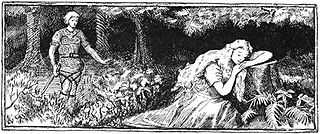
Bragi is the skaldic god of poetry in Norse mythology.

Hrungnir is a jötunn in Norse mythology. He is described as made of stone and is ultimately killed in a duel with the thunder god Thor.
Bestla is a jötunn in Norse mythology, and the mother of the gods Odin, Vili and Vé. She is also the sister of an unnamed man who assisted Odin, and the daughter of the jötunn Bölþorn. Odin is frequently called "Bestla's son" in both skaldic verses and the Poetic Edda.
Bölþorn is a jötunn in Norse mythology, and the father of Bestla, herself the mother of Odin, Vili and Vé.
Geirröðr is a jötunn in Norse mythology. He is the father of the gýgjar Gjálp and Greip, who are killed by the thunder-god Thor.
Gjálp and Greip are two jötnar in Norse mythology and the daughters of the jötunn Geirröðr. They are killed by the thunder god Thor for trying to kill him.

Hymir is a jötunn in Norse mythology, and the owner of a brewing-cauldron fetched by the thunder god Thor for Ægir, who wants to hold a feast for the Æsir (gods). In Hymiskviða, Hymir is portrayed as the father of Týr, but in Skáldskaparmál, Odin is Týr's father.

In Nordic mythology, Fjalar and his brother Galar, were wicked dwarfs who killed Kvasir and turned his blood into the mead of poetry, which inspired poets. They appear in Skáldskaparmál.
Gillingr is a jötunn in Norse mythology, and the father of Suttungr. Gillingr and, later, his wife are murdered by the dwarfs Fjalar and Galar. In revenge, his son Suttungr tortures the dwarfs into giving him the mead of poetry.

In Norse mythology, Suttungr was a jötunn and the son of Gilling.

Gunnlǫð is a jötunn in Norse mythology. She is the daughter of Suttungr, for whom she guards the mead of poetry. Saturn's moon Gunnlod is named after her.
Járnsaxa (; Old Norse:, is a jötunn in Norse mythology. In Snorri Sturluson's Prose Edda, she is portrayed as Thor's lover and as the mother of Magni, a child with supernatural powers.
Gríðr is a jötunn in Norse mythology. She is the mother of Víðarr the silent and the consort of Odin. Saturn's moon Gridr was named after her.

Hyrrokkin is a female jötunn in Norse mythology. According to 13th-century poet Snorri Sturluson, she launched the largest of all ships at Baldr's funeral after the Æsir gods were unable to budge the vessel.

In Norse mythology, the Poetic Mead or Mead of Poetry, also known as Mead of Suttungr, is a mythical beverage that whoever "drinks becomes a skald or scholar" able to recite any information and solve any question. This myth was reported by Snorri Sturluson in Skáldskaparmál. The drink is a vivid metaphor for poetic inspiration, often associated with Odin the god of 'possession' via berserker rage or poetic inspiration.

In Norse mythology, Óðrerir, Óðrørir or Óðrœrir refers either to one of the three vessels that contain the mead of poetry or to the mead itself.

In Norse mythology, Rati is the name of a drill or auger that was used by Odin during his quest to obtain the mead of poetry from the giant Suttung with the help of Suttung's brother Baugi. According to the Skáldskaparmál section of the Prose Edda, Odin instructed Baugi to bore a hole with the auger through the mountain Hnitbjorg where the mead was kept. When Baugi told him that the hole had been drilled, Odin blew into the hole and the stone bits blew back at him. In this way he realized that Baugi had not drilled all the way through and was trying to trick him. Odin told him to drill a second time, and this time when he blew into the hole the bits flew inward. Odin then transformed himself into a snake, and when he slithered into the hole Baugi tried to stab him with the auger but missed him. In this manner Odin gained access to the mead.
In Norse mythology, Hnitbjörg is the mountain abode of the giant Suttungr, where he placed the mead of poetry for safekeeping under the guardianship of his daughter Gunnlöð. Odin, with the help of Suttungr's brother Baugi, drilled a hole into the mountain and thereby gained access to the mead.

Skáldskaparmál is the second part of the Prose Edda, compiled by Snorri Sturluson. It consists of a dialogue between Ægir, the divine personification of the sea, and Bragi, the god of poetry, in which both stories of the Æsir and discourse on the nature of poetry are intertwined. The work additionally includes tales of human heroes and kings. The overarching mythological setup gradually fades and the work becomes more of an early form of a poetic thesaurus of Old Norse, presumably intended for usage by skalds. Much of the work is focused on poetic phrases and descriptors. The origin of these kennings is given; Bragi delivers a systematic list of kennings for various Æsir, people, places, and things. He then goes on to discuss poetic language in some detail, in particular heiti, essentially poetic synonyms or alternate words. For example, the simple hestr, "horse", might be replaced by jór, "steed".
Fjalar is the mythical red rooster that is said to herald the onset of Ragnarök in Norse mythology.









